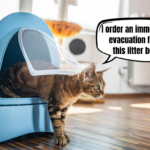Tales of so-called “mischievous” cats are as common as fur on your couch. Over our 12+ years in the cat world, we’ve heard them all: knocking plants off windowsills, avoiding the litter box, meowing incessantly at all hours, surprise attacks on unsuspecting feet. But today, we’re here to clear the air, fabCats, and defend feline honor. Because let’s face it—cats don’t act out of malice. They’re just loudly communicating their needs; sometimes, we humans miss the memo. Ready to decode their behavior with us?
Mission 1: Tame the Boredom Beast
Boredom is one of the most overlooked feline needs. Many people still believe that cats are self-sufficient entertainment machines. That’s a myth! Like dogs need walks, cats need daily stimulation. When left unchallenged, they’ll find creative (and sometimes destructive) ways to amuse themselves. Give them reasons to stay engaged instead of scolding your kitty for their antics. Here’s how:
- Regular Playtime: Morning and evening sessions work best, aligning with your cat’s natural hunting instincts. Use toys that mimic prey to engage your cat’s inner predator. Afterward, finish the play session with a meal or treat—your cat will purr in gratitude (and probably nap).
- Enrich Their Environment: Cats see their home in 3D and love exploring vertical spaces. Install shelves, perches, and scratching posts to create a feline jungle gym. This lets your cat climb, jump, and patrol their domain without breaking your valuables.
- Quality Time Together: Beyond feeding and cleaning the litter box, spend intentional time with your cat. Whether playing or binge-watching your favorite series, your presence matters. Denied your attention, cats often find ways to demand it.
Mission 2: Rule Out Health Issues
One of the common causes of undesirable behaviors that may seem like feline malice is health problems. This includes more severe issues, such as kidney disease causing litter box troubles, as well as more mundane ones, like an injured paw or damaged claw, making your cat reluctant to feel the litter under their paws. Cats experiencing pain might relieve themselves outside the litter box, vocalize excessively, release tension through aggression, or damage objects around them to alleviate their frustration and relieve pain. Identifying a health-related cause for unwanted behaviors is challenging because the answer often doesn’t appear in blood or urine tests. But that doesn’t mean you can ignore it—a visit to the vet is a must so you can be sure, fabCat, that everything is okay with your furry friend. Only after that should you contact a behaviorist to work together to uncover the true cause of your cat’s quirks. There’s a good chance that small changes in your daily routine or interior design will make feline “malice” disappear like magic.
Mission 3: Understand Feline Needs
Health, play, a full bowl, a place to scratch and lounge, human companionship—this list of basic feline needs is likely well-known to you, dear fabCats. However, it’s worth revisiting occasionally, especially when your cat does something that might not earn your approval. Cats don’t see their behavior as “good” or “bad,” so when they meow loudly to call you to the kitchen, jump on your desk to wave their tail during an important work meeting or attack your guests’ ankles, they must have a good reason. Don’t punish your cat for behaviors that come naturally to them—instead, adapt your environment to balance the needs of both the cat and the human. At the same time, show your cat that for every “no” you impose, there’s an even better alternative that they’ll love.
Example:
Take scratching posts—a topic close to our hearts. Someone might say, “My cat has scratching posts, but they still scratch the couch out of spite.” No, dear friend, that’s not the case. The cat simply scratches the couch because it’s likely more stable, more pleasant for their paws, or better positioned than the scratching post meant to replace it. So, when choosing a scratching post for your kitty:
- Pick one that won’t wobble when they scratch it. Stability is key.
- Choose a surface that’s a pleasure to scratch.
- Don’t place it in the corner of the room—scratching posts act as feline signposts, used to mark territory, so place it somewhere meaningful to your cat.
If your cat scratches the couch, they’re showing you the perfect spot for the scratching post!
We’ve already written about unwanted feline behaviors on our blog, so if you want more examples and strategies, we warmly invite you to check it out: https://blog.mykotty.pl/en/2022/08/08/how-to-train-a-cat-to-stop-their-unwanted-behavior-lets-work-on-cat-habits/
For now, we’re off to attend to the needs of our own cats so they don’t type out a secret message to you on the keyboard asking for rescue. Until next time, fabCats!





